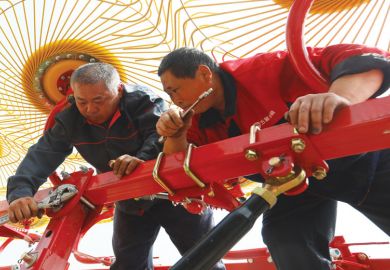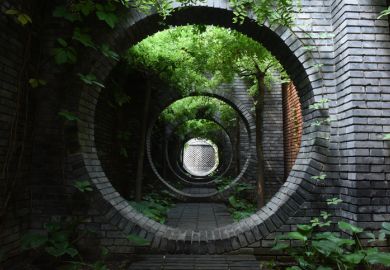The Cambridge Archaeological Journal ( CAJ ) is the fortunate child of its mother institution, the McDonald Institute for Archaeological Research in Cambridge. Inasmuch as it was Colin Renfrew's achievement in persuading businessman Daniel McDonald to part with £11 million to build and endow an eponymous institute for archaeological research, the journal owes it existence to these two men. Yet genealogy alone does not guarantee a successful scholarly journal.
Thoughtful organisation and a clear and far-sighted view of how to deal with the increasing complexities of modern archaeology are key elements in designing a new journal. One reason why the CAJ succeeds is the ingenious and flexible mix of formats in each volume, which allows for a diversity of approaches to writing about the past. This gives the editor, Chris Scarre, and his editorial board considerable latitude in deciding how to respond to the range of topics offered to them. It also invites (and challenges) potential authors to argue their case concisely in one of the agreed formats. Each volume has two issues and, generally speaking, each issue adheres to a structure that sees five main articles, a review feature or viewpoint section, shorter notes and review articles (that is, book reviews).
It is impossible to do justice to each of the 13 issues reviewed here and so what follows inevitably reflects personal interests. A handful of contributions indicates the range and vibrancy of the journal. Sarah Tarlow's article on the archaeology of remembering as seen through death and bereavement of the first world war is highly original, offering insights into issues that arguably would not have been published in an archaeological journal even a decade ago. Stephen Shennan's design of a computer model to explore analogies between genetic transmission of information between generations and processes of cultural transmission is equally innovative, as is the provocative review feature by Jacques Cauvin et al , which discusses the religious and symbolic imperatives for the origins of agriculture. David Brown's erudite account of Mesopotamian cuneiform conceptions of celestial space and time is unexpectedly relevant to modern society, and Edward Luby's and Mark Gruber's interpretation of the symbolic meanings of shellmounds near San Francisco adds a significant new dimension to investigating features previously interpreted only from the perspective of subsistence ecology.
Despite such a rich and varied array of topics, there are, interestingly, a number of articles and review features that may be seen as investigating aspects of significant larger themes. I choose one of these putative larger themes to make several interrelated points. We begin in 1995 with an article by J. D. Lewis-Williams on seeing and meaning in South African San rock art. Lewis-Williams's work on San art has been justly influential and provocative, but the emphasis on entoptics has been challenged as promoting neurological determinism in ways that degrade our ability to identify individual and cultural imagination and imperatives. In other words, it stands accused of privileging a narrow class of neuro-psychological phenomena, arguing that images, shapes and designs in art are the autonomic consequence of altered states of consciousness rather than the result of conscious, purposeful and meaningful selection by a society.
This emphasis on entoptics is contextualised by Lewis-Williams's adoption of Mircea Eliade's classic, yet problematic definition of shamanism as a psychosomatic state entered by shamans to deal with the spirit world. Thus we have a powerfully seductive conceptualisation of shamanism that acts as a "universalising explanatory mechanism" despite the fact that many would argue that the idea of "pure shamanism" is hard to sustain.
The application of entoptics/shamanism to explain prehistoric art and material culture is an enlightening thread that can be traced through many volumes of the journal. In the same issue as Lewis-Williams's article is a review feature of Maya Cosmos: Three Thousand Years on the Shaman's Path by David Freidel, Linda Schele and Joy Parker. Both Freidel and Schele have made significant contributions to understanding Maya studies, especially glyphic decipherment. Their focus picks up on shamanism as a universal explanation of Maya art and cosmology. They see Maya kings as super-shamans, and Maya art as replete with typically shamanic imagery. Thus everything is explained in one neat equation that sees a culturally complex past through the lens of a comparatively simple present.
Other examples, emphasising entoptics, include Jeremy Dronfield's paper on alternative realities, art, and cognition in Irish passage-tombs, Lewis-Williams and Jean Clottes's essay on the application of the former's ideas to Palaeolithic cave art, David Whitley et al on the excavation and interpretation of Sally's Rockshelter in the Mojave Desert, and Christopher Chippindale et al on Australian rock art. Only Robert Layton, in his review feature of Clottes and Lewis-Williams's book The Shamans of Prehistory: Trance and Magic in the Painted Caves , offers a reasoned critique of what has become a lumbering bandwagon.
There appears a dangerous assumption in many archaeological publications that entoptics/shamanism somehow legitimately underwrites interpretation of diverse materialities. There are several criticisms. The existence of geometric shapes in art does not prove they were the result of images experienced by shamans in the early stages of trance. There is no reason to suppose that every geometric form from the Palaeolithic to modern Amazonian societies is entoptic in nature, nor that any society will artistically privilege entoptically inspired imagery. Layton makes two linked and powerful points - that in the well-documented art of Australian Aborigines, geometric forms are common, but there is no ethnographic support for an entoptic interpretation, and that the entoptic approach mistakenly equates the existence of shamanism with the presence of entoptic phenomena as if there exists a universal and axiomatic relationship between the two.
Picking up on the second point, it often appears as if archaeologists regard shamanism as a convenient "one size fits all" application. Ignoring the historically contingent variety of different kinds of shamanic activity, a "generalised ethnographic shamanism" is constructed, then projected backwards to explain all manner of prehistoric material culture and assumed behaviours. This seems to miss the point entirely.
What defines a "shamanic world view" is not strict adherence to predetermined image-bearing stages of altered states of consciousness, but rather the acknowledgement of a non-western, indigenously coherent, concept of "explanation and being" based on analogical symbolic reasoning. This fundamental characteristic provides the explanatory framework and power to underwrite the diversity of culturally specific world views that differentially draw on, and assign meanings to, naturally occurring and induced altered-state images. Such a conceptual understanding of the world empowers priests, chiefs, as well as "true" shamans, and appears often to have been a feature of the power wielded by Maya kings, Egyptian pharaohs and Chinese emperors.
An arguably more fruitful approach is to investigate the more "obvious" and accessible aspects of non-western world views that emphasise the multi-sensorial nature of human existence and particularly the importance of light and colour in human cognition. The CAJ explores these issues in three important contributions.
The first appeared as a viewpoint in 1999, titled "What meaning had colour in early societies?", where John Gage et al explored cultural perceptions of colour in ancient Egypt, Aboriginal Australia, European archaeology and early cloth and clothing. Here, in outline, is a wealth of evidence concerning brilliance and colour, both metaphysically and reified as material culture.
In 2000, Stephen Houston and Karl Taube wrote a path-breaking article titled "An archaeology of the senses: perception and cultural expression in ancient Mesoamerica". Grounded in the rich archaeological, artistic and ethnohistorical records of Mesoamerica, it made a powerful case for what they callJ"cultural synaesthesia", where the senses of smell, hearing and sight were linked. Here, stimulus in one - sight - triggered perception in another - hearing and smell. For the Classic Maya, peripheral vision acquired moral and hierarchical significance, the perfume of flowers enchanted the elite and celestial light was embodied and represented as eyes. The sweetness of breath and the sound of speech and music were expressed through aromatic flowers and shining jade. Significantly, for assessing the nature of the Mesoamerican world view and natural philosophy, the qualities of sound and scent appear to have been integrated with concepts of the soul.
More speculative, but equally insightful in approach, is David Trevarthen's paper in the same issue, called "Illuminating the monuments", which explores the use of multicoloured stones and shadows in the megalithic cairns at Clava in Scotland. It was found that cobbles of the passage graves were red (sandstone and quartz-feldspar) in the southwest and white (granite and mica schist) in the northeast. These monuments were made of materials chosen for colour, texture and sparkle, and aligned so as to allow shadows to mark the seasons. These are facts, but as the author rightly states, the use of such materialities to contextualise emotionally charged rituals of symbolic death, rebirth, and rites of passage is speculation. Nevertheless, there are parallels with the use of quartz in Sally's Rockshelter, and indications that archaeology can get to grips with such elusive concepts by innovative fieldwork coupled with carefully applied ethnographic analogies and anthropological theory. The ideas explored in these three CAJ articles indicate how a powerful new way of investigating the past based on testable physical realities and informed speculation. How different and full of potential is this way of thinking compared with a reductive appeal to trancing dancing shamans and phosphenes.
My bias is clear, but it is not the point. Far more important is that such a stimulating and wide range of articles on such diverse topics have appeared in one journal over just a few years. Not only are these pieces of the highest scholarly quality, but they can be seen as part of a developing scholarly discourse that embraces distinct yet overlapping theoretical approaches.
As a coda to this discussion, I would mention Joshua Pollard and Clive Ruggles's investigation into spatial order, cosmology and patterns of deposition at Stonehenge. In a paper on that most over-publicised monument, and which deals with the slippery concept of prehistoric cosmology, there is no mention of loose shamanic analogies. Instead we have a clear-headed analysis informed by, and grounded in an intimate familiarity with, archaeological realities and astronomical phenomena. The authors argue convincingly for a relationship between lunar motions and deposits of human bone, and against a commonly assumed shift from a mainly lunar to a mainly solar cosmology in mid-third-millennium Wessex.
This review reflects the excellence of the CAJ 's content and the success of its editorial policy and strategy. Where archaeology is increasingly an anthropologised and interdisciplinary endeavour, flexibility, open-mindedness and a willingness to embrace diverse, innovative and provocative approaches is paramount. In this, the CAJ is an unqualified success.
Nicholas Saunders is lecturer in material culture, University College London.
Cambridge Archaeological Journal
Editor - Chris Scarre
ISBN - ISSN 0959 7743
Publisher - Cambridge University Press, twice a year
Price - Individuals £26.00 Institutions £70.00
Register to continue
Why register?
- Registration is free and only takes a moment
- Once registered, you can read 3 articles a month
- Sign up for our newsletter
Subscribe
Or subscribe for unlimited access to:
- Unlimited access to news, views, insights & reviews
- Digital editions
- Digital access to THE’s university and college rankings analysis
Already registered or a current subscriber? Login



